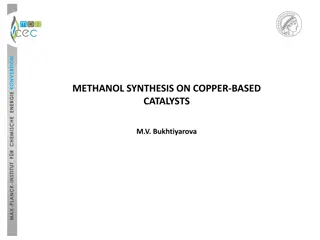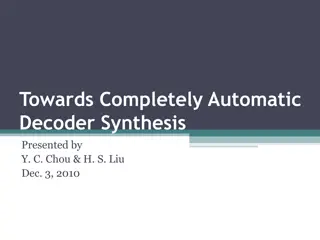SAT-Based Exact Synthesis Using DAG Topology Families
Explore the world of exact synthesis in digital circuit design utilizing SAT solvers to achieve precise results. Understand the challenges, decision problems, algorithms, motivation behind exact synthesis, and the contribution of SAT solvers in mitigating runtime. Discover the concept of DAG topology families and how they aid in enumerating valid DAG structures for circuit synthesis.
Download Presentation

Please find below an Image/Link to download the presentation.
The content on the website is provided AS IS for your information and personal use only. It may not be sold, licensed, or shared on other websites without obtaining consent from the author. Download presentation by click this link. If you encounter any issues during the download, it is possible that the publisher has removed the file from their server.
E N D
Presentation Transcript
SAT Based Exact Synthesis using DAG Topology Families Winston Haaswijk1, Alan Mishchenko2, Mathias Soeken1, Giovanni De Micheli1 1Integrated Systems Laboratory, EPFL 2University of California at Berkeley
Exact Synthesis (ES) ES Algorithm Gives exact result (with respect to cost function) Not to be confused with approximate computing! SAT Based ES Use SAT solvers to implement such algorithms 2
Exact Synthesis Decision Problems Given a function and a number We may ask different exact synthesis related questions 1. Two-level ES : Does there exist a SOP expression with cubes that represents ? 2. Multi-level ES : Does there exist a logic network with gates that represents ? 3
ES Algorithms Two-level Algorithms Multi-level Algorithms SOP minimization Quine-McCluskey [1] Petrick s method [2] ESOP minimization Perkowski [3] Sasao [4] Decomposition Ashenhurst decomposition [5] Roth-Karp decomposition [6] Enumeration Knuth [7] Amaru [8] SAT Een [9] Kulikov [10] 4
SAT Based ES Given function f Recall question (can we find such a network?) We can encode this question as CNF formula Initialize r = 0 Generate SAT Encoding _r Our contribution: novel encodings which are easier to solve Solve F SAT UNSAT Found optimum ntk Set r = r + 1 5
Motivation Exact Synthesis is Hard E.g. size-optimum ES is the Minimum Circuit Size Problem [11] Conjectured to be intractable [12] SAT itself is NP-complete Runtime Unpredictable: given CNF, how much time will SAT solver take? Hard to parallelize 6
Contribution In SAT based ES, SAT solver conceptually solves two tasks in parallel 1. Enumerate valid DAG structures 2. Assign operators to nodes (labelling) This work: mitigate runtime by helping SAT solver with task 1, using (families of) DAG topologies 7
DAG Labelling Suppose we want to synthesize a full adder We are given additional information: a DAG structure Can we put operators on DAG nodes to make the DAG a full adder? We call this labelling a graph Can be translated to CNF formula Given to SAT solver label This labelling operation is fast Several orders of magnitude faster than conventional ES 8
Shortcomings of Labelling Why not use labelling to perform ES? Problem: while labelling is fast, search space is too big 4175098976430590000 1E+19 1E+18 1E+17 Nr. of DAGs 1E+16 1E+15 1E+14 1E+13 1E+12 1E+11 1E+10 1E+09 100000000 10000000 1000000 100000 10000 1000 100 10 1 0 1 2 3 4 5 6 7 8 9 10 9 Nr. of nodes
DAG Topology Families We cannot enumerate all DAGs Instead, enumerate families of DAG topologies They provide additional topology information to the SAT solver Which gives us similar advantages to DAG labelling We call such families fences Given two integers and A fence is a partition of nodes over levels NOTE: such a partition is not unique! 10
Fences Example Example of the fences in There are 4 fence families A colored group of nodes is a single fence Fences have a nice regular structure Counting and generating them is quite simple NOTE: much fewer fences than DAGs E.g. there are only 512 fences for 10 nodes 11
Fences Contain DAGs Fences fix part of a DAG structure: the distribution of nodes over levels Every DAG belongs to a unique fence Fences are agnostic to connectivity or fanin size This is desirable as basis for synthesis algorithms 12
ES With Fences Suppose we have a fixed topology of gates 4, 5, 6 We want to add gate 7 There are multiple places to add it, and different fanins we could choose Conventionally, SAT solver has to consider all different combinations Using fences, we fix the position of the gate (to a specific level) They also limit the number of fanin connections to consider This constrains the SAT search space and reduces the number of variables Takeaways: 1. There are not many fences, and generating them is fast 2. Using fences allows for simpler and smaller CNF formulas 13
Experimental Results Mean Runtime (ms) Number of timed out instances 1000000 300 100000 250 10000 200 1000 150 100 100 10 50 1 0 NPN-4 FDSD-6 PDSD-6 FDSD-8 PDSD-8 NPN-4 FDSD-6 PDSD-6 FDSD-8 PDSD-8 SYM ABC TOP SYM ABC TOP Fence based runtime dominates baseline Runtime is competitive with state-of-the-art A bit slower for NPN-4 and FDSD-8 (18% and 8%, respectively) Up to 62% faster Fence-based synthesis dominates other all methods Up to 61% fewer timeouts than state-of-the-art 14
Conclusions and Future Work Conclusions We show how families of DAG topologies can be used in SAT based ES Enables significant reductions in runtime, up to 62% Enables significant reductions in number of timed out instances, up to 61% An open source header-only C++ library Part of the EPFL logic synthesis libraries Available at https://github.com/whaaswijk/percy Future work will take place there as well This work has been implemented in the percy library Future Work Use fences as a source of parallelism Alternative topology families Explore continuum between DAGs (completely fixed topologies) and conventional ES (no topology information) 15
SAT Based Exact Synthesis using DAG Topology Families Thanks for your attention Contact winston.haaswijk@epfl.ch https://github.com/whaaswijk https://whaaswijk.github.io
References 1. McCluskey, E. J., Minimization of Boolean Functions, 1956 2. Petrick, S R., A Direct Determination of the Irredundant Forms of a Boolean Function from the Set of Prime Implicants, 1956 3. Perkowski, M., An exact algorithm to minimize mixed-radix exclusive sum of products for incompletely specified Boolean functions, 1990 4. Sasao, T., An Exact Minimization of AND-EXOR Expressions Using Reduced Covering Functions, 1993 5. Ashenhurst, R., The Decomposition of Switching Functions, 1957 6. Roth, J. P. and Karp, R. M., Minimization Over Boolean Graphs, 1962 7. Knuth, D. E., The Art of Computer Programming Volume 4A, 2011 8. Amaru, L. et al., Enabling Exact Delay Synthesis, 2018 9. Een, N., Practical SAT a tutorial on applied satisfiability solving, 2009 10. A. S. Kulikov et al., Improving circuit size upper bounds using sat-solvers, 2018 11. Kabanets, V and Cai, J.-Y. Circuit minimization problem, 2000 12. C. D. Murray and R. R. Williams, On the (non) NP-hardness of computing circuit complexity, 2015 17























